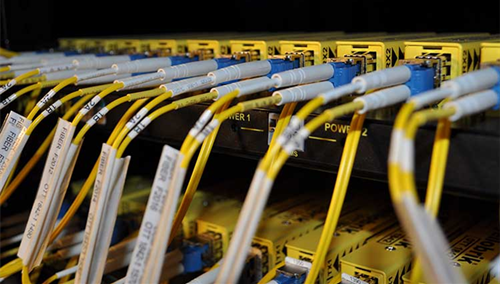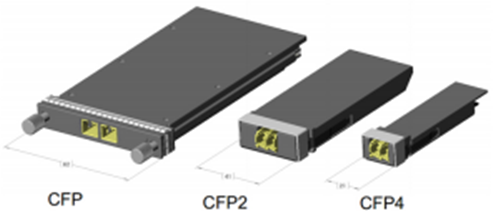Since most data centers today are fueled by more data and great bandwidth, all optical technology including optical transceivers, must face the increasing demand for bandwidth. The technology needs to meet the bandwidth requirements not only for storage and switch applications but also for server applications. From the old 100 mbqs to the existing 40/100G Ethernet, optical transceivers has improved itself to keep path with the higher data rate. Here is what you need to know about optical transceivers and server technology.
Optical Transceivers: Smaller, More Affordable and Less Power Hungry
Network designers require transceiver modules that consumes less power and costs less while being smaller in size. For instance, the packages for optical transceivers are shrinking. They evolved from a 4" x 3.5" footprint to a 2.3" x 0.68" package. This is an essential evolution for optical transceivers as it allows the overall footprint of servers to decrease, making data centers smaller and more streamlined.

In addition, optical-transceiver power consumption has dropped from 10 W to 3 W or lower—a significant stride that has enabled designers to get more out of transceiver technology. Lower power consumption means lower prices in the design and in power costs. These savings are incredible for people in the technology field.
Port density is another important factors in transceiver design. Most data centers consist of multiple racks of switching equipment that can achieve high speeds. To control costs, designers have refined their designs and tried to improve their manufacturing process technologies to assist with this effort. Increasing port density is just one way to decrease system costs.
The Evolution Path of the Optical Transceiver
As noted before, optical transceivers that met the above requirements are typically recognized in the technology world through the SFP multi-source agreement (MSA). Nowadays, the data center have consolidated around optical transceivers in the SFP form factor for server access and around QSFP transceivers for switch-to-switch interconnects. Moreover, when the distance to the access port is less than 5 meters, direct attach copper cables are usually utilized while active optical cables are used for longer distances.
SFP+ (Enhanced Small Form-factor Pluggable ) transceiver plays a key role in 10G transmission with its advantage of compactness, performance and cost savings. For example, JD092B just like other SFP+ modules are widely used in 10G access ports for a long time. However, the situation will be changed in the near future when the access speed increases to 40G and the 10G access ports turn to QSFP. QSFP transceiver is a parallel transceiver which accept 4 electrical input lanes, and operate at 4 x 10 Gbps. Today, 40G QSFP+ like JG661A is widely deployed in data center switching fabrics and ramping up hard as data centers deploy 40GbE, particularly as a high-density 10G interface via breakout cables.
However, IHS Infonetics released a research in May this year which said QSFP28 modules will be deployed in high volumes as data centers transition from 40G to 100G switching fabrics starting in 2016. What’s QSFP28? As we know, the first-generation QSFP transceivers are equipped with four Tx and Rx and each channel has a rate of 10 Gbps. But now each channel of QSFP can transmit and receive data up to 28 Gbps thanks to the development of technology. This type of transceiver is called QSFP28 which is a new trend for 100G applications.

The widely recognized path to achieve 100G is “10GbE-40GbE-100GbE”. And the first fiber optic transceivers that were shipped with 100G transceivers were CFP. But CFP2 soon came along and achieved 5 x 25G (or 10 x 10G) lane electrical interface while it reduced the form factor by half of CFP. Even so, it costs too expensive and the its footprint is too large to trigger mass deployment. After CFP2, CFP4 which is half the size of the CFP2 has been launched. Meanwhile, there is another form factor namely QSFP28 mentioned above competing with it.
Optical Transceivers and Server Technology Affect Each Other’s Performance
Increased bandwidth is the everlasting topic of telecom field. And just as the saying goes, a man without distant care must have near sorrow. To cope with the ever-increasing bandwidth, every designer must find solutions that will optimize the systems they are designing or implementing for future proofing.
Despite how revolutionary optical transceivers were back when it was first created, it was a rudimentary tool at best. The demand for high port density transceivers started back in 2003 and since then, these devices have become increasingly smaller in a short amount of time. Optical transceivers with smaller packages actually play an important role in reducing overall server footprint, and smaller transceivers means smaller and more streamlined data centers.
Apart from making data centers smaller, the reduction of transceiver sizes also means that it uses less power, which in turn means lower prices as far as power costs and designing is concerned. This is a significant development in transceiver technology, and is shaping the way designers create these devices and get more out of it as an innovative technology.
Data centers are processing tons of data and need to retrieve at record speeds, which requires that every aspect of the design be optimized, including the optical transceiver technology. The above article has concluded several points about how optical transceiver react to the server technology. Fiberstore as a professional manufacturer offers a large variety of telecom products.
评论
发表评论